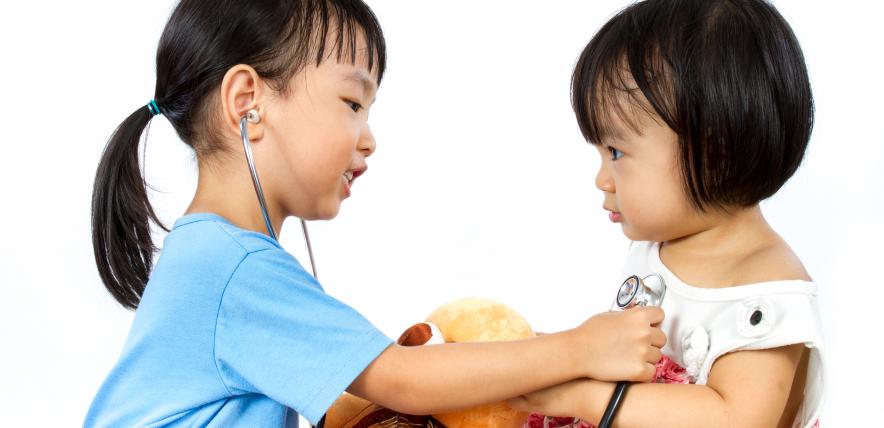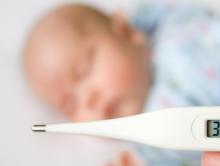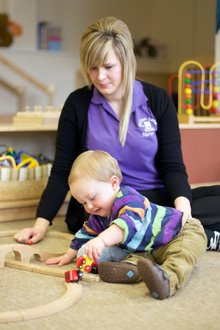When your little one attends pre-school, nursery or a childminder their still-developing immune system will be exposed to new enemies in the form of bugs, parasites and minor infections.
Children pass germs on easily because they are likely to cough and sneeze all over each other, and play in very close contact, while sharing toys.
If you ever become concerned about your child’s health, seek immediate advice from your GP or pharmacist. In the meantime, here’s a round-up of some of the most common childhood ailments, and what to do about them.
Chicken pox
This virus is very common in childhood, and once you’ve had it, you usually can’t get it again. Your child gets a high temperature, then possibly a blotchy rash, which fades after a couple of days and is replaced by red, fluid-filled blisters which scab over in five to seven days, then disappear. It’s infectious for about 48 hours before the rash appears until all the spots have scabbed over and are no longer weeping. Your child may feel quite poorly, whilst other children will appear to be fine except for the itching – it varies from child to child.
How to treat it
A lukewarm bath with bicarbonate of soda - or putting porridge oats in a sock tied at the top into the bath - will help to ease the itching. Or you can put calamine lotion on the spots. Try to discourage scratching as this can cause scarring.
Prevention - Vaccination
Chicken pox vaccines are not routinely available on the NHS, but it's recommended for adults and children in regular or close contact with someone who is vulnerable for example if a sibling is undergoing chemotherapy.
Find out more about chicken pox vaccines
Conjunctivitis
The membrane that lines the white of the eye can become pink and inflamed due to infection, allergy or irritation. Bacterial conjunctivitis is very infectious, and your child’s eye will be sticky with a yellowish or greenish discharge.
How to treat it
Speak to your pharmacist about the best course of treatment. Your child should have their own towel and flannel at home to avoid passing on the infection. If your child’s eyes are ‘glued’ shut after sleep, wipe them with cotton wool soaked in cooled, boiled water.
Hand, foot and mouth disease
This virus causes blisters on your child’s palms, soles of the feet and inside the mouth. Your child may have a sore throat, high temperature, a runny nose and feel poorly, then after a couple of days the blisters appear – they’ll be itchy and sore. It’s infectious until the blisters dry up.
How to treat it
The fluid from the blisters transmits the infection, so don’t burst them, but cover them with gauze dressings to dry out if absolutely necessary. Wash your hands every time you touch them. The sores in their mouth may make it hard to eat and drink so offer easy-to-swallow foods.
Threadworms
These little worms live in the intestines, and crawl to the edge of your child’s bottom to lay their eggs – usually during the night - which causes itchiness. Look out for your child scratching their bottom, and check their poo, pants and bedding for the worms – they look like tiny pieces of white thread. The eggs can be spread easily from child to child on their hands while they play.
How to treat it
You can get tablets from the pharmacist that kill the worms and eggs. Treat the whole family, and wash all towels and bedding at a minimum of 60°C to kill the eggs.
Sickness and Diarrhoea
Tummy bugs are passed from hand to hand and in the air, so young children can get diarrhoea fairly often. Sometimes it’s accompanied by vomiting - one particularly nasty bug is ‘winter vomiting’, officially called Norovirus, which can rampage through nurseries and schools.
How to treat it
Winter vomiting, and most other tummy bugs, don’t need treatment, as they work their way through your child’s system on their own. It’s important to avoid dehydration, though, so give lots of drinks – and don’t worry about food until your child is ready for it. Wash hands regularly to avoid passing the bug on. Do keep your child away from school, nursery or their childminder for at least 48 hours after the last episode of vomiting or diarrhoea (see A day at home? below).
Headlice
Headlice are little bugs that live near the scalp, and lay eggs – known as ‘nits’ - on the hair shaft. They pass from head to head, and are common in young children as they play in such close contact. They are not a consequence of poor hygiene.
How to treat it
You can buy insecticide lotions and shampoos to kill the lice, but you’ll need to remove all the eggs, too, by regularly combing wet hair with a nit comb, otherwise a new batch will simply hatch out.
Coughs and colds
Young children are very prone to coughs and colds, particularly in winter, as their immune systems are still developing. A cold should clear up within three to ten days, and young children can go off their food or find it hard to eat because of a blocked nose. Children usually cough more during the night as lying down causes mucus to build up in the throat.
How to treat it
Give infant paracetomol for a high temperature, and offer lots of drinks, rest and cuddles. Try decongestant gel or drops to ease breathing, and keep your child’s room humid while they have a cough. If the cough is keeping them awake at night, try a night-time cough medicine. See your GP if your child is struggling to breathe, is coughing up green or yellow mucus, or it seems painful to cough.
Croup
Croup is most common in winter and spring, and can be a bacterial or viral infection. It makes your child’s airways become inflamed, and causes a dry, barking cough. Your child may also have a temperature, difficulty breathing, and a runny nose.
How to treat it
Give infant paracetomol to lower their temperature, and let them inhale steam from a bowl of hot water to ease the cough. During a coughing fit, sit them upright and try and keep them calm. The cough should ease off after a couple of days, but if it doesn’t, call your GP.
Impetigo
This bacterial skin infection causes little fluid-filled blisters around the nose, mouth and eyes. They ooze to begin with, then crust over with brownish-yellow scabs.
How to treat it
You’ll have to see your GP, who can prescribe antibiotic cream or medicine. Your child will be infectious while the blisters are oozing and crusting, until two days after they’ve started antibiotics.
Slapped Cheek
This virus begins with a raised temperature, sore throat and runny nose, and after a few days a very distinctive bright red rash appears on the cheeks – hence the name. After another few days your child may get a raised, red splotchy rash on their chest, stomach, arms and thighs, which can be itchy.
How to treat it
This is mild and usually clears up on its own, but if your child feels unwell, give rest and lots of fluids, or offer infant paracetomol for a fever. It’s good to let your pre-school know your child has had it, as it can be problematic for pregnant women and other vulnerable groups.
A day at home?
It can be frustrating when your child seems perfectly well, but not allowed to attend pre-school because of guidelines on infectious illnesses. Each nursery follows current NHS guidance on exclusion times and must adhere to these in order to keep your child and every other child who attends healthy. Here are some of the most common rules:
Sickness and diarrhoea Stay at home while they’re ill and for 48 hours after symptoms disappear.
Conjunctivitis If there are several cases (an outbreak) the pre-school, nursery or childminder may ask you to keep your child at home until they have commenced treatment and their eyes are clear of discharge.
Chickenpox Stay at home for at least 5 days from the onset of the rash or until all the spots have scabbed over.
Impetigo Stay at home until two days after starting the course of antibiotics.
Slapped cheek Your child isn’t infectious once the rash appears so it’s fine to go to pre-school, if your child is well enough.
Written for the Early Years Alliance by Siobhan Godwood.
This article is for information purposes only and should not be used to diagnose your child. If your child is ill and you are concerned you should consult your GP.







